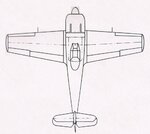- Thread starter
- #21
...
However, if we are into fantasy, a Ki-61 powered by a DB 605A and with a radiator designed following the principles first suggested by Junkers (and used in Bf 109F) but called the Meredith Effect in Britain and the USA might be interesting. For late war, we could have a DB 605 D with a radiator copied from a P-51 (we know that a Spitfire V flew well with a DB 605, so the radiator should work).
...
We can argue that radiator of the Ki-61 used Merredith effect, people at Kawasaki were quick to come out with a radiator much improved over what Ki-60 had. What they lacked on the Ki-61 was the boundary layer splitter.
Japanese judged that Ki-61 with Ha-140 (=1250 HP at 5700m - same as the DB 605A on 2600 rpm) will gain 30 km/h vs. the one with Ha-40, -> 610 km/h. The 16% thick wing (at root), with same series of 2R profiles as on the Bf 109, was probably not all that conductive for very high speed on what was a modest power for 1944 and on.
Granted, the DB 605D will add to the performance, especially with water/alcohol injection - quirk being getting it in Japanese service in numbers and in time.






